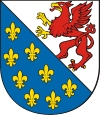Gryfice
Gryfice (pronounced Gri-fitse [ɡrɨˈfʲit͡sɛ] (![]()
Gryfice | |
|---|---|
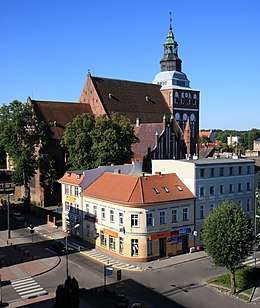 Victory Square and Saint Mary's Church | |
 Flag 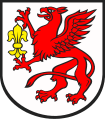 Coat of arms | |
 Gryfice 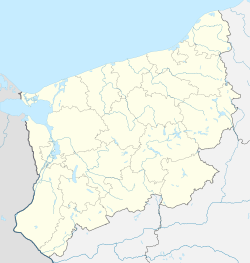 Gryfice | |
| Coordinates: 53°54′53″N 15°11′55″E | |
| Country | |
| Voivodeship | |
| County | Gryfice County |
| Gmina | Gmina Gryfice |
| City rights | 1262 |
| Government | |
| • Mayor | Andrzej Wacław Szczygieł |
| Area | |
| • Total | 12.4 km2 (4.8 sq mi) |
| Population (2017) | |
| • Total | 16,600 |
| • Density | 1,300/km2 (3,500/sq mi) |
| Time zone | UTC+1 (CET) |
| • Summer (DST) | UTC+2 (CEST) |
| Postal code | 72-300 |
| Car plates | ZGY |
| Website | http://www.urzad.gryfice.eu/ |
History
Middle Ages
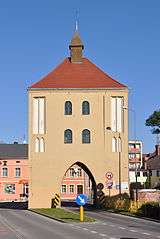
The region was part of Poland during the reign of the first Polish rulers Mieszko I and Bolesław I the Brave. The Battle of Niekładź took place in the area of Gryfice in 1121, in which Polish ruler Bolesław III Wrymouth defeated Wartislaw I, Duke of Pomerania and Swantopolk I, Duke of Pomerania.[3][4] The area was part of the Duchy of Pomerania, a vassal state of Poland, which later on separated itself from Poland as a result of the fragmentation of Poland.
In 1262 Wartislaw III, Duke of Pomerania founded a town under Lübeck law on the Rega river to attract German settlers. After his death, his successor, Barnim I, Duke of Pomerania, named the settlement Civitat Griphemberch super Regam (Middle High German 'Griphemberch' meaning Griffin's mountain) after the coat of arms symbol of the Dukes of Pomerania. In 1365 the town entered the Hanseatic League and prospered due to the right of free navigation on the Rega.
A town wall was built and at the end of the 13th century the construction of the St. Mary's church was begun. In a document of 1386 a Latin school is mentioned, which is generally called the oldest in Pomerania.
Modern era
In the 16th century, the local Germans pursued a policy of Germanisation towards the indigenous population, which, however, did not bring results quickly.[5] At that time, some of the indigenous peasants fled to Poland,[6] while Scottish immigrants settled in the town.[7] As a result of the Thirty Years' War, the population of the town decreased dramatically.[7] The town was occupied by the Imperial and Swedish armies.[7] After the death of the last Pomeranian Duke and by the Treaty of Westphalia Greifenberg became part of Brandenburg-Prussia in 1648 and part of Imperial Germany in 1871. In 1818 the town became the capital of the Greifenberg district (Kreis Greifenberg).
.jpg)
In 1894 the town was connected to the railway line Dąbie (Altdamm) - Kołobrzeg (Kolberg). On July 1, 1896 the Greifenberger Kleinbahn was opened, a narrow-gauge railway today used as a railway Museum. In 1933 a Polish association of agricultural workers was established in Gryfice.[8] Local Poles and Jews were subjected to increased repressions, after the Nazis came to power in Germany in 1933.[9] After the German invasion of Poland, forced labourers from Poland were brought to the town.[10]
At the end of World War II, on March 5, 1945, the Soviet Red Army conquered the town, and on March 8, Poles entered the town. Approximately 40 percent of the town was destroyed, however many historical monuments stayed intact or were reconstructed. Following the post-war boundary changes, the town became part of Poland. Initially called Zagórze, it was eventually given the Polish name Gryfice. The Germans who did not escape during the battle with the Soviets, were expelled and the town was populated with Poles, some of them expellees themselves from Polish areas annexed by the Soviet Union. The post-war administration of Gryfice was created with the participation of the just freed Polish forced labourers.
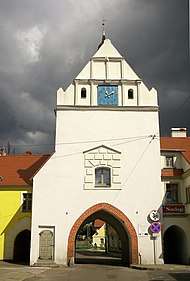
After the war, the life of the town was being rebuilt. In 1945, the first post-war schools, a hospital and a cinema were opened and the following year a mill, a gasworks and a marmalade factory were opened.[11] In 1948 a sugar factory was established, which already in 1951 was one of the leading sugar factories in Poland.[11]
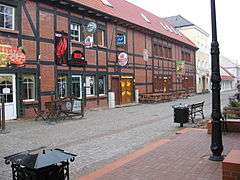

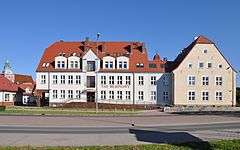
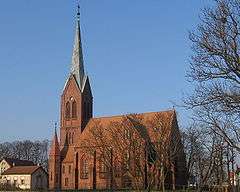
Demographics
Before the end of World War II the (then-German) inhabitants were predominantly Protestant. With the transformation into a Polish town after World War II and the complete exchange of its population, the majority of its population has been composed of Catholics.
| Year | Inhabitants | Notes |
|---|---|---|
| 1740 | 1,724[12] | |
| 1782 | 1,890 | incl. 20 Jews.[12] |
| 1794 | 2,138 | incl. 19 Jews.[12] |
| 1812 | 2,445 | incl. 15 Catholics and 35 Jews.[12] |
| 1816 | 2,610 | incl. 44 Catholics and 35 Jews.[12] |
| 1831 | 3,272 | incl. 13 Catholics and 82 Jews.[12] |
| 1843 | 4,027 | incl. 9 Catholics and 132 Jews.[12] |
| 1852 | 4,886 | incl. 15 Catholics and 129 Jews.[12] |
| 1861 | 5,361 | incl. 31 Catholics, and 134 Jews.[12] |
| 1900 | 6,477[13] | |
| 1925 | 8,370 | incl. 110 Catholics, 80 Jews and 630 others.[14] |
| 1939 | 10,800 | |
| 1946 | 4,900 | after expulsion of Germans after World War II and war losses |
| 1950 | 8,700 | |
| 1960 | 11,600 | |
| 1970 | 13,200 | |
| 1980 | 15,300 | |
| 1990 | 17,600 | |
| 2000 | 17,300 |
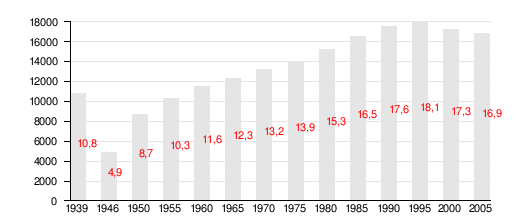
Notable residents
- David Christiani (1610–1688), a German mathematician, philosopher and Lutheran theologian
- Karl Wilhelm Gottlob Kastner, (1783–1857) a German chemist, natural scientist and a professor of physics and chemistry
- Gustav von Struensee (1803–1875) a German writer.
- Herman Schatz (1843–1906) an American politician and blacksmith emigrated to the US in 1851
- Friedrich Heinrich Albert Wangerin (1844–1933) a German mathematician.
- Richard C. H. Lenski (1864−1936), Lutheran scholar, emigrated to the US in 1872
- Conrad Pochhammer (1873–1932) a German physician and surgeon
- Rita von Gaudecker (1879-1968) a German author of books for children and young people
- Moritz Seeler (1896–1942) a German poet, writer, film producer and victim of the Holocaust.
- Ehrengard Schramm (1900–1985) a German politician and writer
- Krzysztof Linkowski (born 1949) a retired Polish runner who specialized in the 800 metres
- Bartosz Nowicki (born 1984) a Polish middle distance runner.
- Grzegorz Krychowiak (born 1990) a Polish footballer, played over 50 games for Poland
International relations
Notes
- "

- "Gmina Gryfice - Położenie". www.gryfice.eu.
- Rodowód książat pomorskich Szczecin 2005 page 94-95, 98
- Richard Roepell: Geschichte Polens, vol. I, Hamburg 1840, pp. 267-268 (in German)
- Stanisław Rzeszowski. Ważniejsze momenty dziejów Gryfic. „Szczecin, czasopismo regionu zachodnio-pomorskiego” p. 32. (in Polish)
- Ziemia Gryficka 1969, p. 103 (in Polish)
- "Gmina Gryfice - XVI-XX wiek" (in Polish). Retrieved June 16, 2019.
- Ziemia Gryficka 1969, p. 130-131 (in Polish)
- A. Poniatowska, B. Drewniak, Polonia szczecińska (1890-1939), p. 61 (in Polish)
- K. Golczewski, Miasto Gryfice i powiat na przełomie lat 1944-1945, p. 60-61 (in Polish)
- "Kronika wydarzeń 1945-1989" (in Polish). Retrieved June 16, 2019.
- Kratz (1965), p. 176.
- Meyers Konversations-Lexikon. 6th edition, vol. 8, Leipzig and Vienna 1907, p. 272.
- Der Große Brockhaus. 15th edition, vol. 2, Leipzig 1929, p. 488.
Literature
- Gustav Kratz: Die Städte der Provinz Pommern - Abriß ihrer Geschichte, zumeist nach Urkunden. Berlin 1865 (reprinted in 1996 by Sändig Reprint Verlag, Vaduz/Liechtenstein, ISBN 3-253-02734-1; reprinted in 2011 by Kessinger Publishing, U.S.A., ISBN 1-161-12969-3), pp. 32–38 (online).
External links
| Wikimedia Commons has media related to Gryfice. |
. Encyclopædia Britannica. 12 (11th ed.). 1911. p. 557.
- Official website (in Polish)
- narrow-gauge railway museum (in German)
- Jewish Community in Gryfice on Virtual Shtetl
